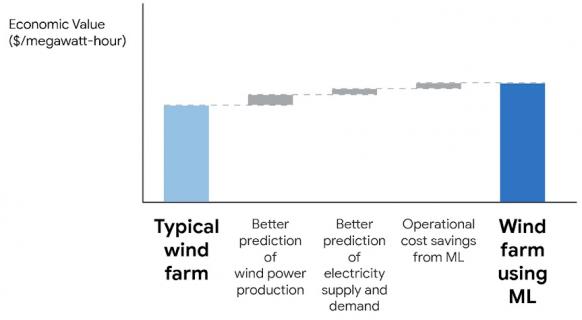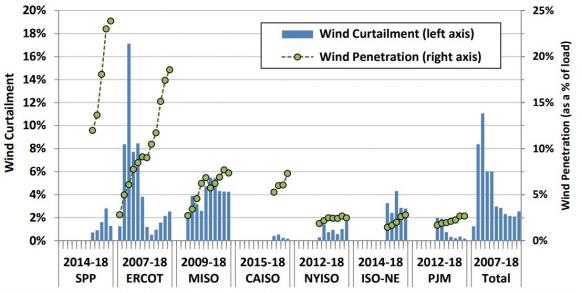Smart wind turbine curtailments cut wildlife energy losses to 1%
New data-reactive turbine controls can halve the number of curtailments used to protect bats and birds while predictive systems can generate deeper fleet savings, technology developers told New Energy Update.

Related Articles
As wind power operators seek new ways to increase returns, new technologies are being developed to reduce the cost of curtailment.
Wind farm curtailment can be due to a number of factors, including inadequate transmission grid capacity or other localized factors such as inflexible generation capacity and interaction with bats and birds.
Technology developers are leveraging growing computing power and the latest sensor technologies to limit the impact on wildlife and project revenues.
The U.S. Department of Energy (DOE) is currently funding several projects in this area, including an acoustic monitoring system developed by Natural Power that processes echolocation calls and can then trigger a curtailment process almost instantly. California's Electric Power Research Institute (EPRI) is also field-testing automated curtailment technology while Maine-based Stantec Consulting Services is developing a predictive model that measures the risk effectiveness of smart curtailment strategies.
Natural Power is now developing a technology that can integrate real-time data on bat presence and wind speed into the wind turbine control system. The company will work with the U.S. National Renewable Energy Laboratory (NREL) to ensure the system meets NERC cyber security and compliance.
This data-reactive system can cut the number of curtailments by around 50% and reduce the need for blanket curtailments during peak bat collision periods, Christine Sutter, Head of Wildlife Technology, Natural Power, told New Energy Update.
By following a smart curtailment strategy for wildlife protection, operators can cut losses in annual energy production (AEP) to around 1%, compared with 5% for blanket curtailment strategies, Sutter said.
Predictive gains
An alternative to using real-time detectors and turbine controls is to implement "passive" monitoring of bat activity and other variables to build a curtailment program, Trevor Peterson, Project Manager, Stantec, told New Energy Update.
Smart curtailment strategies can then be implemented across the wind fleet, "focusing on projects within the fleet that have higher fatality rates as opposed to applying a single strategy across a fleet," Peterson said.
Growing analytics and forecasting capabilities are allowing operators to implement predictive and preventative operations and maintenance (O&M) programs to maximize uptime.
Google recently combined machine learning with U.S. wind turbine data and weather forecasting to increase the value of its wind assets by 20%, the company said in February.
Google applied DeepMind applied machine learning algorithms to 700 MW of U.S. wind capacity, allowing it to predict wind power output 36 hours ahead.
Value gains from Google machine learning
(Click image to enlarge)
Source: Google, DeepMind
These predictive capabilities become more valuable as wind subsidies end and more turbines are exposed to wholesale market prices.
Access to quality site data on weather and other environmental conditions is critical to reducing curtailment losses, Kevin Armstrong, Head of Natural Power's UK Control Centre, said.
"The key to successful curtailment is in forecasting," Armstrong said.
The “more data you have, the better data you have, and the less curtailment there needs to be,” he said.
Grid balancing
Growing installed wind capacity raises the risk of curtailment, but regional grid constraints can play a larger role.
In the Texas ERCOT market for example, grid expansion measures drastically cut curtailment rates between 2010 and 2014 despite rapid increases in wind power penetration, the DOE noted in its 2018 Wind Technologies Market Report. Between 2014 and 2018, wind curtailment crept up to 2.5% as wind penetration doubled to over 14%.
US wind curtailment, penetration rates by ISO
(Click image to enlarge)
Source: US Department of Energy's 2018 Wind Technologies Market Report.
Market operators must implement adequate compensation for wind curtailment in order to optimize regional wind fleets, Peterson said.
The cost of curtailment varies widely, depending on factors such as turbine capacity and market prices.
Pricing structures could be implemented based on the value of asset curtailment over a full year of operations, Peterson said.
“A market-based incentive could be really effective,” he said.
Storage value
Advancements in storage technology are also set to impact curtailment strategies.
Many renewable energy developers are now deploying battery technology to maximize the market value of their assets.
UK utility ScottishPower is currently building a 50 MW lithium ion battery facility at its Whitelee wind farm in Scotland. ScottishPower recently became the first UK power utility to generate 100% of its electricity from wind energy and reportedly plans to build at least six energy storage projects planned by end of 2020.
At current costs, batteries can currently only provide a few hours of capacity economically and alternative storage systems which allow longer dispatch or seasonal storage could help improve wind power business models.
The U.S. wind industry must develop new storage solutions in the coming years to fend off surging competition from solar power developers, Wood Mackenzie Power and Renewables said in a report last month.
"Absent of a step change in turbine performance or cost reductions, it is increasingly obvious that for wind to compete amidst ever increasing renewables penetration, a long-term energy storage solution must be developed to cope with wind’s weekly and seasonal boom/bust cycle," it said.
By Ed Pearcey


